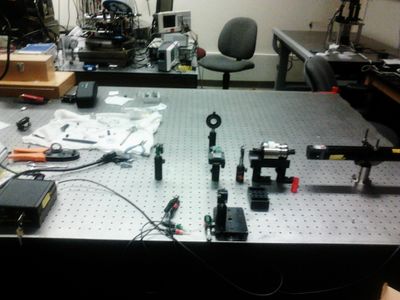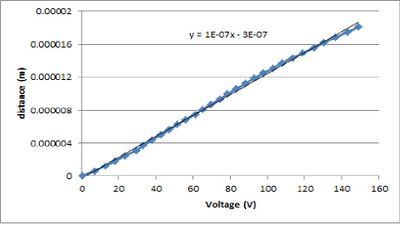Interferometers
The goal of the spectroscopy project was to create a michelson, mach-zehnder and sagnac Interferometer. Each setup utilized a 632.8nm Helium-Neon laser.
In order to reduce fringe-drift, the michelson interferometer employed both an optical iris and an optical isolator. The setup of the michelson interferometer is shown in Figure 1.
The Michelson interferometer was used to measure both the "voltage-to-expansion" ratio of a PZT and the coherence length of the He-Ne laser.
To measure the "voltage-to-expansion" ratio, the PZT was wedged in the track of he adjustable mirror. By increasing the voltage across the PZT and simultaneously counting the number of fringes that passed an arbitrary point on the projection screen, it was possible to measure the expansion distance of the PZT using the relation d=m*lambda/2. Multiple measurements were recorded and plotted in Figure 2.
The slope of the graph indicates the PZT expands at a rate 100nm/Volt.
To measure the coherence length of the He-Ne laser, mirror 1 was gradually moved backwards until the interference pattern was no longer readable. The coherence length <l>, is given by the relation <l>=2*d, where d is difference in interferometer arm lengths. The measured coherence length was 78cm.
The mach-zehnder interferometer setup is shown below:
As with the Michelson interferometer, an optial iris was employed to minimize outside noise. However, the optical isolator proved unnecessary with the Mach-Zehnder interferometer as no fringe drift was observed.
The Setup of the Sagnac interferometer is shown below.

